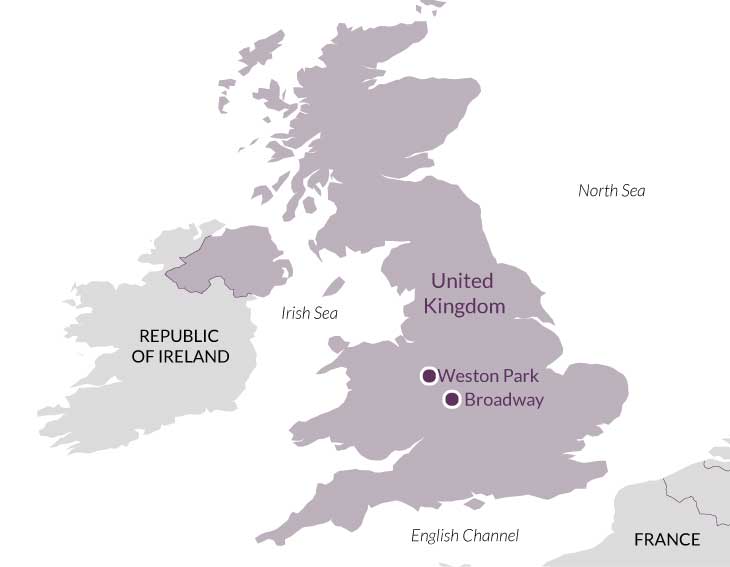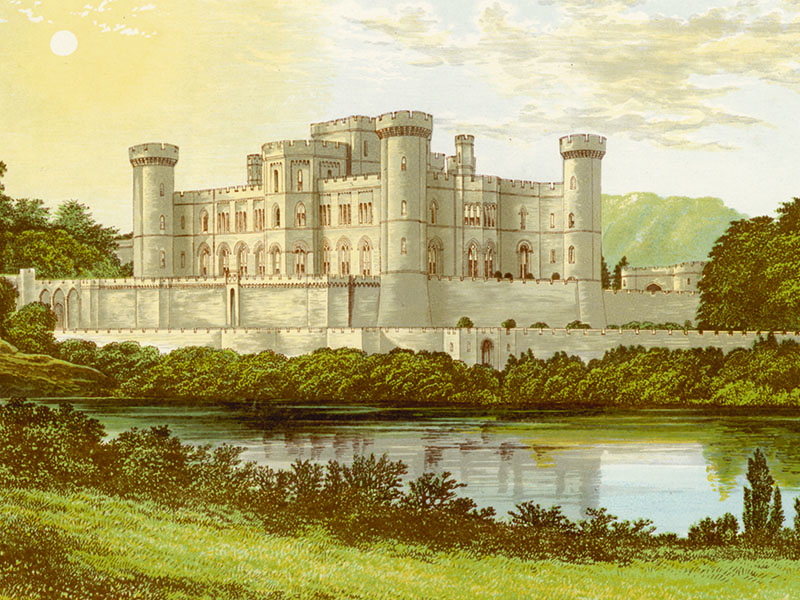Overview
Along the Welsh borders are some of the most enchanting landscapes in Britain, largely unspoilt thanks to being beyond the reach of metropolitan commuters. Its agriculture remains small in scale, family farms and artisan food producers maintaining earlier field systems with hedges and an abundance of trees.
The houses visited illustrate the evolution of taste over many centuries. Hellens perfectly demonstrates the adaptation of a small monastery into one of Britain’s most atmospheric houses, deeply rural yet playing its part in national affairs. Ragley is the only surviving example of a country house designed by the polymath Robert Hooke, colleague of Sir Christopher Wren. Classicism shaped Hanbury, Shugborough and Attingham. Eastnor combines Norman and Gothic Revival elements while Madresfield’s many reconstructions have produced a house resembling a moated Elizabethan mansion but, like Wightwick, it is celebrated for its Arts & Crafts interiors.
Important parks surround some of the houses: Weston Park has one of the few remaining ‘Capability’ Brown pleasure grounds, several are by Repton and the magnificent group of mostly Greek-inspired monuments in the park at Shugborough is a landmark in eighteenth century architecture.
A very special feature of this tour is that participants stay for three of the five nights in one of these houses. Weston is in essence a late seventeenth-century mansion filled with fine paintings – Holbein, Van Dyck, Gainsborough, Reynolds, Stubbs – and furniture and other arts. Formerly the property of the Earls of Bradford, it belongs to a private charitable trust. It is not a hotel, but caters for high-end special events. Our group has exclusive access, and while there this great country house is your home. You are free to wander through the house and grounds at leisure.
Day 1
Eastnor Castle. The coach leaves Gloucester Railway Station at 12.00 noon. Spectacularly situated above a lake, early-19th-century Eastnor is a splendid example of the Norman and Gothic revival, with a drawing room by Pugin. The sumptuous and beautifully restored interiors are hung with paintings by Van Dyck, Reynolds, Romney and Watts. First of two nights in Broadway.
Day 2
Hellens, Madresfield Court. Transformed from a monastery into a fortress in 1292 by Mortimer, Earl of March, Hellens has been lived in ever since by his descendants. Edward the Black Prince dined in the stone-flagged hall and the Tudor, Jacobean and Stuart additions contain paintings and heirlooms from the Civil War, fine 17th-century woodwork and Cordoba leather wall hangings. The novelist, Evelyn Waugh, was a frequent guest at Madresfield, where the oldest part is the 12th-century Great Hall. Rebuilt in the 16th, 19th and 20th centuries, the house is famous for its Arts & Crafts chapel and library.
Day 3
Ragley Hall, Hanbury Hall. Of several great houses designed by the scientist and architect Robert Hooke, Ragley is the sole survivor, though it was not completed until long after his death with additions by James Gibbs and James Wyatt. Described as ‘every Englishman’s idea of a substantial squire’s red brick home of the age of Wren’, Hanbury was built c. 1700 and decorated with wall- and ceiling-paintings by Sir James Thornhill. The garden and orangery were designed by George London. First of three nights at Weston Park.
Day 4
Weston Park. Today is spent at Weston Park with its curator, Gareth Williams. The predominantly 17th-century house has an excellent picture collection, outstanding furniture, including choice pieces by Chippendale. An in-depth tour includes items not usually on display. There is time also to explore at leisure and walk in the ‘Capability’ Brown park.
Day 5
Wightwick Manor, Shugborough. Wightwick Manor is one of the finest examples of the Victorian penchant for an ‘Old English’ amalgam of stone, brick, half-timbering and tile-hanging, but it is also distinguished by its collection of Pre-Raphaelite paintings and William Morris furnishings. Shugborough has all the elements of a substantial country estate: a magnificent Georgian house with a fine collection of paintings, silver and ceramics; Grade I-listed parkland peppered with classical monuments; a working model farm; and a lively family history.
Day 6
Attingham Park. Set in parkland designed by Humphry Repton, Attingham has magnificent Regency interiors and one of the first picture galleries to be built in a country house. It is filled with the collection of Italian furniture, paintings and silver formed by the diplomatist 3rd Lord Berwick. The tour ends at Shrewsbury Railway Station by 3.20pm and at Wolverhampton Railway Station by 4.30pm.
Price, per person
Two sharing: £2,960 . Single occupancy: £3,120.
Included
Accommodation as described below; breakfasts, three lunches and four dinners with wine or beer, water, soft drinks, coffee; private coach; all admissions and donations; all tips; the services of the lecturer and tour manager.
Accommodation
The Lygon Arms, Broadway: a 16th-century coaching inn; some parts date back to the 14th century. Situated in the high street of Broadway. Weston Park, Weston-under- Lizard: set in 1,000 acres of ‘Capability’ Brown parkland. A country house where one may stay, rather than a hotel, offering the experience of being a guest while the family is away.
How strenuous?
Unavoidably, there is quite a lot of walking on this tour and it would not be suitable for anyone who has difficulties with everyday walking and stair-climbing. Coaches can rarely park near the houses, many of the parks and gardens are extensive and the houses visited don’t have lifts. Average distance by coach per day: c. 47 miles.
Are you fit enough to join the tour?
Group size
Between 12 and 22 participants.

'A very good balanced series of country houses, all different in their own ways and all fascinating.'
'Everything was of such a high standard - from the lecturer and tour manager to the accommodation and food.'
'I could not think of a single thing that could have been improved.'
'Just the right mixture between grand palatial homes and smaller houses of architectural and cultural interest. Weston Park was a grand, unforgettable experience.'
'Weston Park was outstanding.'
